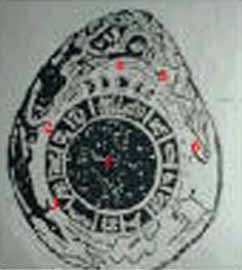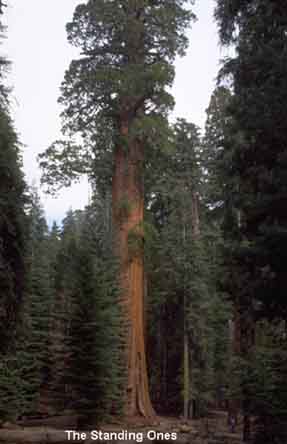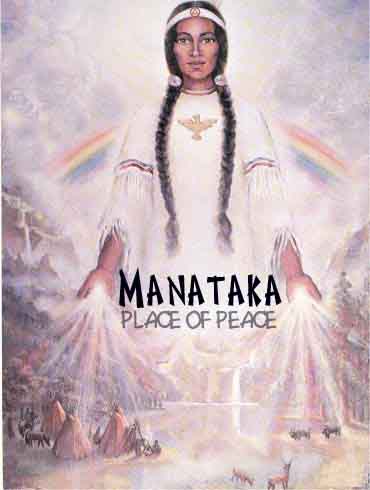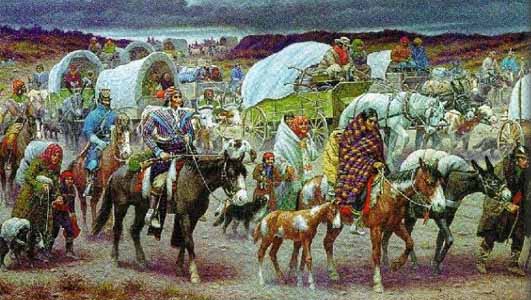

The Story of Manataka The Place of Peace - The Sacred Mountain and the Valley of the Vapors... For thousands of years, this magnificent site was the gathering place of many nations. Tribal leaders and spiritual elders made pilgrimages to the Great Ma-na-ta-ka Mountain to sit in great councils with many tribes. Some came every seven years, others came every eleven years, and others made the journey more frequently depending on local custom. Tribal leaders prayed and made peace offerings to the Creator, the Great Manataka - "Place of Peace Mountain" and each other.

They danced and sang around huge campfires in the narrow valley situated between the Manataka mountain and her sister mountain, today called North Mountain. Her other sister mountain, today called Indian Mountain stood guardian to her east. Daughters of the first nations gathered rare medicinal herbs found in great abundance in a large area surrounding Manataka in the shape of a circle. Their sons found precious clear crystals, gold, silver, pyrite, and whetstones. Spiritual elders also brought gifts from their tribes to Manataka. Some gifts were intended to establish friendships and diplomacy between various tribes and others were personal gifts between long-time friends. Trade items were also exchanged on blankets spread out in dozens of camps just outside the sacred valley. Other, more precious gifts brought to Manataka were not intended for humans, but were ceremonial offerings for the sacred mountain.
It is said by the grandfathers that seven holy caves were on the sacred mountain. The center cave is made of magnificent shining crystal encoded with messages of the star people. Inside the crystal cave are seven crystal cones set on a crystal altar and each contain secret messages and seven shields. Ancient tribes came to Manataka on pilgrimages to place ceremonial items in five of the caves.
The people of the south laid gifts in the southern-most cave and people of the north laid their gifts in the northern-most cave. Two other caves were used by the people from the west and east for offering ceremonies. The cave located to the left of the crystal cave was used by the Keepers of Manataka, the Tula Indians of Tanico, who lived in surrounding areas and for other tribes living nearby such as the Caddo, Quapaw, Osage, Tunica, and Pawnee.
To the right of the center crystal cave was a ceremonial cave reserved for gifts of the other people of this land - the animals, birds, fish, insects, plants, stones and the elements. No one ever approached the most sacred crystal cave, as it was said to have been the work place of the Star People and resting place of many spirits. The southern-most cave, nearest the surface of the ground, once held the Manataka Stone, or as referred to by the National Park Service as the Calendar Stone brought by people from the south.
The Calendar Stone was removed after the Civil War by workmen digging on the mountain to capture the sacred waters of Nowasalon and build ornate bathhouses for the rich. An ancient clay doll was recovered from the northern cave some time in the early 1900's by workmen and is currently on loan to the Smithsonian Museum in Washington. Each of the seven caves disappeared a various times after the invasion began in the 1500's, either at the hand of the invaders or by natural or supernatural causes.

Everyone sought healing and pleasure in the magical hot waters of Nowasalon - Breath of Healing that spewed from the sides of the mountain creating dozens of crystal clear pools. No one was allowed to enter the Valley of Vapors carrying a weapon into the sacred area decreed by the Great Mystery as the Place of Peace. No fighting or discord was allowed. Should anyone violate these laws, they were taken outside the valley and severely punished.

The Lady of the Rainbow, referred to as Ix Chel by the Maya, was said to have presided over the peace in the valley. Dressed in all white buckskin and holding one eagle feather in each hand, she stood on the mountain overseeing the peace. When quarrels did arise, a vision of the Rainbow Woman could be seen at twilight rising in the vapors of the highest pool as a warning to the offending person. If the guilty one did not listen to this warning, the Lady of the Rainbow came to him and dropped one feather at his feet, which meant it would be wiser to fly away than to disturb the peace again. If this warning was not heeded, she dropped the second feather as a sign to his family and others to remove the offender from the valley by whatever means necessary.
Our Grandfathers saw dense green forests surrounding the narrow valley.
Steam rose from abundant hot springs on the side of the mysterious mountain.
The valley was shrouded in misty vapors which feathered the lush underbrush and curled upward through the tall trees.
Sometimes the vapors joined low clouds to float away in the pink evening sky.
Other times they lay lightly upon the ground like a soft blanket or swirled around the bubbling crystal pools.
Manataka was a place of strange, mystical beauty. Everywhere, the sound of trickling water made sensual music as it bathed the bare faces of fractured cliffs and splashed into creeks at the bottom of the mountain.
In places where the steaming waters issued from the rock, growing cones of tufa covered with exotic mosses cupped in shades of red and orange painted the calcareous rock.
Particles of silica, washed by the sun, sparkled like millions of diamonds while pyrite fragments seemed to catch fire and glow. The most magnificent sight to behold at Manataka was seen from miles away in any direction.
Indian elders on pilgrimage may have said to their fellow travelers, "We know we are there when the sign in the sky appears."
The sign was a huge, beautiful rainbow stretching across the entire valley.
The Rainbows of Manataka would not disappear after a few minutes of glory in the sun like all other rainbows.
Manataka's rainbows would build and build in size and would become more colorful throughout the day because of the constantly running hot and cold water springs.
The Rainbows of Manataka were not only a natural wonder of the world and a magical sight, they held a very special meaning.
We believe the rainbow has a sacred purpose. The rainbow is a sign of the Creator's Great Blessing.
Wherever the rainbow appeared it was a place appointed by the Great Spirit - Creator for people to gather, especially those of differing origins and interests. It was a place where even enemies sat in peace.
It is at Manataka, under the rainbows that the nations gathered by direction of the Creator for His purpose.
Manataka is truly the place of peace for all people.
The area was a cultural and trade center for all native peoples - a great melting pot of American Indian culture.
The Valley of the Vapors was neutral territory unclaimed by any tribe.
The Great Spirit decreed that all that visited here were to lay down their weapons and bathe as brothers in the healing waters.
Even tribes who were hostile to each other acknowledged the truce while in the Place of Peace.
The Caddo were the dominant people in areas surrounding the valley. The Quapaw, Osage, Tunica, Natchez, Pawnee and Shawnee were nearby.
There is disagreement between archeologists, ethnologists and historians as the exact number of tribes that may have visited Manataka.
Some say there may have been 34 language groups who considered the Valley sacred ground.
In an effort to diminish any sort of future claim on Manataka, others say there were none who visited here.
Stories of the Sacred Valley of Peace still exist among some tribes today.
Other tribes, whose languages have been largely lost since the European invasion, speak of Manataka as if it were a mythical place.
In the early 1500's, Spanish conquistadors mounted expeditions to find the legendary spring whose magic waters could rejuvenate the elderly and heal the sick.
In 1512, Ponce DeLeon failed in his attempt to reach the mysterious hidden valley containing a crystal fountain of healing water known as the Fountain of Youth.
His fellow explorer, Hernando DeSoto was the first white European invader to enter the Valley of the Vapors in 1541.
Desoto's chroniclers wrote about the amazing sites they beheld. As far as the eye could see were hundreds of lodges representing tribes from every part of the vast continent.
The colorful dress of various groups was different from one another and they spoke many distinct languages.
Ceremonial and tribal dances were held in a central plaza, and elders sat in circles smoking the pipe.
Almost immediately after first contact, the original inhabitants began to disappear.
European invaders sacked the land, spread disease and incited inter-tribal wars that all but decimated dwindling native populations during the next two and half centuries.
After the Louisiana Purchase in 1803, white invaders began to settle in the Valley of Vapors.

In 1832, President Jackson, mastermind of the Trail of Tears and other racial atrocities, was looking for a way to totally demoralize and disorient native populations.
Jackson pushed Congress to take an unprecedented action in the nation's history by confiscating the most holy site in the American Indian world, Manataka, and making it the nation's first federal reservation.
The confiscation of Manataka by Jackson was an act contrary to the terms of the Louisiana Purchase and against the Constitution of the United States.
The United States government promised the French, Spanish and native tribes in negotiations preceding the Louisiana Purchase the federal government would not violate sacred sites.
Jackson was warned by the U.S. Supreme Court the government was prohibited by the Constitution to own land [There is still no provision in the Constitution for the government to own land].
Thus, the only legal way Jackson could accomplish the take-over was to pass a provisional law steering around treaties with other nations and the U.S. Constitution.
Jackson wanted to create the first commercial federal reservation.
As a popular president and famous Indian fighter, this was an easy task as members of Congress, of which not one of its members had ever seen Manataka, looked the other way.
For the next four decades the government allowed settlers build bathhouses and residences around the springs but in 1875 the it forced the settlers out and later began selling off choice pieces of property to selected businessmen.
What was left of the Hot Springs Federal Reservation after the ravages of the settlers and greedy government agents was turned over to the newly created national park system in 1921 and became the second national park after Yellowstone. Today, it is known as Hot Springs National Park, Arkansas.
Settlers and the U.S. government destroyed the sacred Circle and the seven ceremonial caves containing the Manataka Stone and other ancient artifacts gifted to Manataka by the tribes. Stolen artifacts were sold for profit by government agents.
Government bureaucrats, to cover up gross negligence of the past, claim there were never any caves on the mountain, regardless of strong evidence to the contrary.
Out of forty-seven hot water springs surviving the early onslaught of settlers, the government covered all but two small hot water display springs with metal and concrete in the name of "protecting visitors and the environment."
Actually, the reason is to control the sacred waters for profit. They pump the waters to private bathhouses and hotels where it can be sold.